
The Nikon FE is an advanced semi-professional level, interchangeable lens, 35 mm film, single-lens reflex (SLR) camera. It was manufactured by Nikon in Japan from 1978 to 1983, and was available new from dealer stock until c. 1984. The FE uses a metal-bladed, vertical-travel focal plane shutter with a speed range of 8 to 1/1000 second, plus Bulb, and flash X-sync of 1/125th second. It had dimensions of 89.5 millimetres (3.52 in) height, 142 mm (5.6 in) width, 57.5 mm (2.26 in) depth and 590 grams (21 oz) weight. It was available in two colors: black with chrome trim and all black. As on the FM, its model designation did not appear on the front of the camera, but was engraved as a small "FE" preceding the serial number on the rear of the housing.
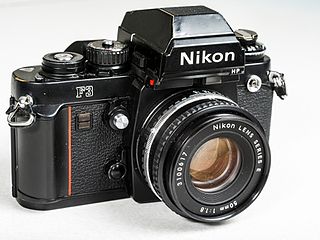
The Nikon F3 was Nikon's third professional single-lens reflex camera body, preceded by the F and F2. Introduced in March 1980, it had manual and semi-automatic exposure control whereby the camera would select the correct shutter speed. The Nikon F3 series cameras had the most model variations of any Nikon F camera. It was also the first of numerous Nikon F-series cameras to be styled by Italian designer Giorgetto Giugiaro, and to include a red stripe on the handgrip – a feature that would later become a signature feature of many Nikon cameras.

The Canon A-1 is an advanced-level single-lens reflex (SLR) 35 mm film camera for use with interchangeable lenses. It was manufactured by Canon Camera K. K. in Japan from March 1978 to 1985. It employs a horizontal cloth-curtain focal-plane shutter with a speed range of 30 to 1/1000 second plus bulb and flash synchronization speed of 1/60 second. It has dimensions of 92 millimetres (3.6 in) height, 141 millimetres (5.6 in) width, 48 millimetres (1.9 in) depth and 620 grams (22 oz) weight. Unlike most SLRs of the time, it was available in only one color; all black. The introductory US list price for the body plus Canon FD 50 mm f/1.4 SSC lens was $625; the camera body was generally sold with a 30–40% discount.

The Nikon FG is an interchangeable lens, 35 mm film, single-lens reflex (SLR) camera. It was manufactured by Nippon Kogaku K. K. in Japan from 1982 to 1986.

The Nikon F-501 was the first successful autofocus SLR camera sold by the Nikon Corporation beginning in 1986. A nearly identical, albeit manual focus version, called the Nikon F-301 was also available. Subsequent models in the consumer line included the Nikon F-401, Nikon F-601, and Nikon F-801 / F-801s.

The Canon EOS 5 is a semi-professional autofocus, autoexposure 35 mm SLR film camera. It was sold from November 1992 onwards, and was replaced in late 1998 by the Canon EOS 3. As part of the EOS line of cameras, the 5/A2/A2e utilized Canon's EF bayonet lens mount, first introduced in 1987.

The Canon EF is a manual focus 35mm single-lens reflex camera produced by Canon between 1973 and 1978. It was compatible with Canon's FD-mount lenses. The EF was built as an electro-mechanical version of Canon's top-of-the line wholly mechanical Canon F-1. The shutter is mechanical at all speeds ½ second and faster, but at 1 second and longer the shutter is all electronically controlled, allowing AE exposures from 1/1000 to 30 seconds. The EF shares the F-1's rugged construction and tough metal body. Unlike the F-1, the EF does not support any motor drive for film transport. Neither does it provide any interchangeable viewfinder.
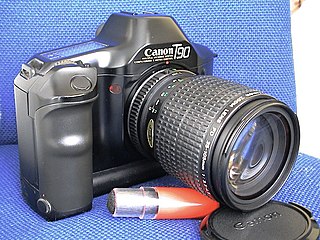
The Canon T90, introduced in 1986, was the top of the line in Canon's T series of 35 mm Single-lens reflex (SLR) cameras. It is the last professional-level manual-focus camera from Canon, and the last professional camera to use the Canon FD lens mount. Although it was overtaken by the autofocus revolution and Canon's new, incompatible EOS after only a year in production, the T90 pioneered many concepts seen in high-end Canon cameras up to the present day, particularly the user interface, industrial design, and the high level of automation.
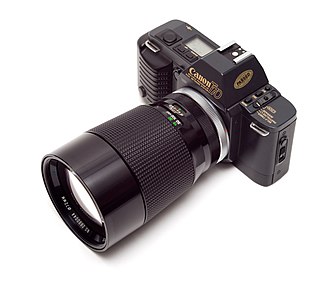
The Canon T70 was a 35mm FD-mount single-lens reflex camera introduced in April 1984 as the second in Canon's T series. The T70 started with the concepts explored in 1983's T50, took them further, and applied them to a more sophisticated camera. While the Program AE-only T50 was intended as a beginner's camera, the T70 gave the photographer a lot more control over the camera's operation while keeping the T-series philosophy of simplicity in control and operation intact.

The Canon F-1 is a 35 mm single-lens reflex camera produced by Canon of Japan from March 1971 until the end of 1981, at which point it had been superseded by the New F-1 launched earlier that year. The Canon FD lens mount was introduced along with the F-1, but the previous Canon FL-mount lenses and older R- series lenses were also compatible with the camera with some limitations. The Canon F-1 was marketed as a competitor to the Nikon F and Nikon F2 single lens reflex cameras by Nikon.
The Olympus OM System was a line of 35mm single-lens reflex cameras, lenses and accessories sold by Olympus between 1972 and 2002. The system was introduced by Olympus in 1972. The range was designed by Yoshihisa Maitani, chief designer for Olympus, and his staff; OM stands for Olympus Maitani.
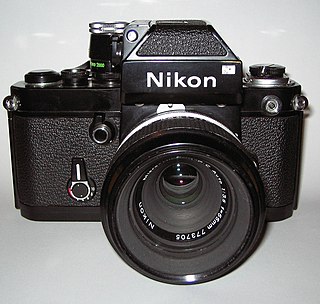
The Nikon F2 is a professional-level, interchangeable lens, 35 mm film, single-lens reflex (SLR) camera. It was manufactured by the Japanese optics company Nippon Kogaku K. K. in Japan from September 1971 to 1980. It used a horizontal-travel focal plane shutter with titanium shutter curtains and a speed range of 1 to 1/2000 second plus Bulb and Time, and flash X-sync of 1/80 second. It had dimensions of 98 mm height, 152.5 mm width, 65 mm depth and 730 g weight. It was available in two colors: black with chrome trim and all black. The F2 was adopted by both casual photographers and professional photographers, the latter of those especially photojournalists covering the later half of the Vietnam War.
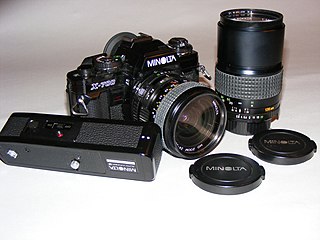
The Minolta X-700 is a 35 mm single-lens reflex film camera introduced by Minolta in 1981. It was the top model of their final manual-focus SLR series before the introduction of the auto-focus Minolta Maxxum 7000.
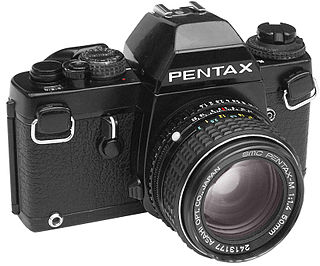
The Pentax LX is a 35mm single-lens reflex camera produced by Pentax in Japan. It was introduced in 1980 to commemorate the 60th anniversary of Asahi Optical Co., and was produced until 2001. It is the top-of-the-line professional, or "system", camera in the Pentax manual focus range, with manual and aperture priority automatic exposure modes and an advanced light metering system. The LX uses the K mount, which is the Pentax proprietary bayonet lens mount, and has a large body of accessories. The camera has several unique or uncommon features, and compared with contemporary professional camera bodies from rival manufacturers, like the Canon New F-1 or Nikon F3, the LX body is smaller and lighter, weighing in at 570 grams with its standard FA-1 finder.

The EOS-1N is a 35mm single lens reflex (SLR) camera body produced by Canon. It was announced by Canon in 1994, and was the professional model in the range, superseding the original Canon EOS-1. The camera was itself superseded by the EOS-1V in 2000.
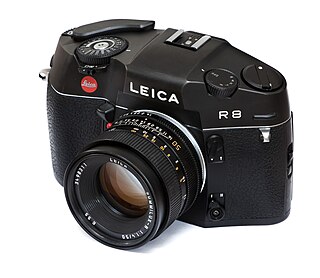
The Leica R8 & R9 are manual focus 35 mm single-lens reflex cameras produced by the German firm Leica as the final models of their R series. Development of the R8 began in 1990: the camera was introduced at the 1996 photokina trade show, and was succeeded by the similar Leica R9 in 2002.

The Pentax ME F was an amateur level, interchangeable lens, 35 mm film, single-lens reflex (SLR) camera. It was manufactured by Asahi Optical Co., Ltd. of Japan from November 1981 to 1984. The ME F was a heavily modified version of the Pentax ME-Super, and a member of the Pentax M-series family of SLRs. It was the first mass-produced SLR camera to come with an autofocus system.

The Canon EOS 100 is a 35 mm autofocus SLR camera introduced by Canon in 1991. It was marketed as the EOS Elan in North America. It was the second camera in the EOS range to be targeted at advanced amateur photographers, replacing the EOS 650.

The Minolta X-1 was the professional model in the Minolta SR-mount line of single-lens reflex cameras (SLR), released in 1972 after ten years of development, which was the first X-series camera in the Minolta SLR system; prior to the X-1, specific Minolta SLR models were branded SR-T, and afterward, they included X in the name. The X-1 was the first SLR to combine an electronically-controlled shutter with interchangeable viewfinders.

The Pentax 6×7 is a SLR medium format system film camera for 120 and 220 film, which produces images on the film that are nominally 6 cm by 7 cm in size, made by Pentax. It originally debuted in 1965 as a prototype dubbed the Pentax 220. Since then, with improvements, it was released in 1969 as the Asahi Pentax 6×7, as well as the Honeywell Pentax 6×7 for the United States import market. In 1990, it received a number of minor engineering updates and cosmetic changes and was renamed as the Pentax 67.


































